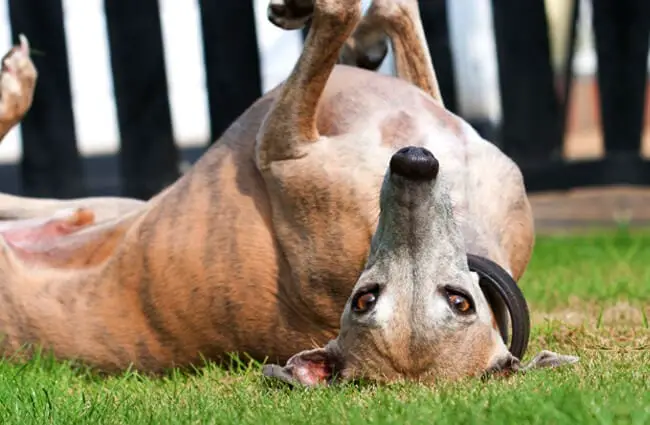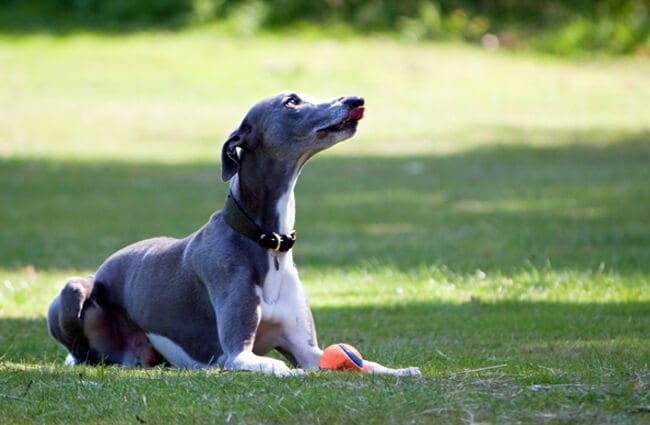The whippet, nicknamed the “poor man’s racehorse,” is known for its incredible speed. They are best known for competing in “rag races,” chasing a tissue or cloth around a track. Originally bred by English poachers in the 18th century, this breed was great at catching small game, like rabbits and gerbils.
The whippet is a unique and athletic dog, often confused with the Italian Greyhound. The whippet, while fast and athletic, is an extremely friendly and calm family companion. Read on to learn more about the whippet.
Description of the Whippet
The whippet is one of the best all-purpose dogs, mastering agility courses, flyball, and lure coursing. Originally used in “snap contests,” in which the dogs were placed in a ring with rabbits, to see which dog could snatch up the most, it was discovered that whippets are easily attracted to chasing a small rag. Racing these dogs, by dragging a waving rag in front of the group, became widely popular among working class men.
Whippets are a thin-bodied breed with long athletic legs, which lend to their incredible speed. Compared to other dogs of their size, when given the chance, this breed will leave most in the dust!
The whippet is a short haired, smooth-coated breed that comes in nearly every color and marking combination imaginable – whether brindle, white, black, blue, red, and more! Their short coat makes them adaptable in warm weather, but not very hardy in the cold. Add a nice doggy winter coat on colder walks, and this friend can surely romp around happily in the snow.
This gentle and affectionate breed is known for being oddly calm indoors and extremely excitable outdoors. Proper exercise and nutrition will make for a great indoor companion, but if your whippet is not well-exercised, he may become destructive indoors.
Life Expectancy and Size
The whippet generally lives about 12-15 years. Proper breeding, nutrition, and exercise will allow him to live and long and happy life. The standard male whippet stands 19-22 inches tall, averaging 34 pounds. The female stands 18-21 inches tall, and averages 29 pounds.
The whippet is a naturally thin breed, and a well-researched owner will know to maintain its sleek figure. It is important to not overfeed your whippet, as an overweight dog will not be able to enjoy sprinting as much. Overfeeding may reduce your dog’s lifespan by stressing and straining his body unnecessarily.
Protective Ability
If you’re looking for an intimidating guard dog that will alert you to every passing neighbor, mailman, and squirrel, keep looking! The whippet is known for being a fairly quiet breed that rarely barks, making them a calm companion, but the last to alert of an unwanted guest.
Training
The whippet is known for being a very obedient breed. With proper training and socialization, this breed can be a wonderful addition to any family. This dog is known for fitting in well with most family lifestyles, as long as given a safe place to run and show off its sprinting skills.
This dog excels in reward-based training and, given its obedient nature, learns quickly and aims to please. Correction-based training is not ideal for the whippet, and may result in avoidance or fear of their owner.
These dogs need proper socialization as puppies, otherwise whippets have the tendency to be timid and stressed. Introduce your puppy to new things while he is young, and reward-reward-reward for all positive interactions and new experiences!
This svelte breed is a natural born sprinter, not a long-distance runner, so training your whippet in agility courses, or just allowing him to run free in a safely enclosed park, will make for a well-tired pup.
It is especially important to remember that this dog has a high prey drive, given its history and breeding. It is vital that you keep your whippet on leash unless in a securely fenced in area. These dogs are extremely fast, and will take off at a moment’s notice to pursue rabbits, birds, or even leaves.
Energy Level
The whippet is a surprisingly gentle and relaxed breed when given proper daily exercise. He is a sprinter, which means that he will run for short distances, but tires quickly. Once well exercised, your dog will happily snooze on the couch and watch TV, or cuddle up next to your feet for warmth.
The whippet is a smart and independent breed, making it great for agility courses. Utilize the dog’s speed and easy obedience to make for a mentally and physically satisfied companion.
What Living with a Whippet is Like
The whippet has become popular today due to their easy-going temperament and unique look. Although this dog requires daily exercise, he is a loveable breed that makes for a relaxed, cuddle-worthy companion. Without proper daily exercise, however, he will become destructive.
These dogs are fairly adaptable to various lifestyles, and given their quiet, laid back nature, make for a great apartment dog. Whippets have a strong prey drive, so make sure to keep them on leash until they are safely contained in a fenced in, secure area to sprint and romp around. The whippet is great for an owner who wants to stay active and can provide a safe, secure space to run.
Given their high prey drive, the whippet is not well-suited for a home with a cat or other small animals. This breed is known for being good with other dogs, and great with children. It goes without saying, but it is especially important with a new puppy in the house, to teach children how to properly interact and play. Any dog, when poked and prodded enough, may negatively react, even such a sweet companion like this one.
Lastly, remember that, as a short haired breed with low body fat, this dog is not suited for outdoor living, and should remain indoors unless being exercised. If you are walking your pup in cold temperatures, provide a stylish doggy jacket to help insulate him!
Care of the Whippet
The whippet, while energetic, is best-suited for warmer climates. This is not to say you can’t have a whippet in snowy climates, but extra care and attention will be needed to make sure that he is okay during winter walks. This is a low maintenance pup with minimal grooming needs, making him widely adaptable, and a loving addition to any family.
Environmental Needs
The whippet is not a suitable outdoor dog, so he should be kept indoors unless specifically outside for a walk or run. They generally do better in warmer climates, and get cold easily when it is wet or snowy outside.
Exercise Needs
As a small prey hunting dog, the whippet is a sprinter, and remains true to that skill. This dog requires daily exercise, ideally given a large open and secure space to sprint. It’s important to not over-exercise your puppy because this breed can easily strain joints. A good rule of thumb is for every month of age, you can add an additional 5 minutes of exercise per day. For example, a 6-month-old whippet can exercise for up to 30 minutes.
Do not rely on voice commands or electronic leashes/fences – this hunting dog can, and will, dart after small prey when given the chance. A shock will unfortunately not deter him from continuing the hunt. Rely on physical fences and leashes rather than fallible shock tools.
This breed thrives in agility courses, and loves open spaces for sprinting, so provide these outlets daily!
Shedding and Grooming
Grooming for this dog is fairly simple. Weekly brushing ensures that they will maintain a soft, shiny coat, but otherwise they’re a low-maintenance breed. Of course, brushing their teeth several times a week and trimming nails as needed are required with all breeds.
Ideal Home Environment
This is a fairly adaptable breed that does well in city dwellings as well as in the country. The main concern with whippets is adaption in cold weather, which requires a coat and even little dog booties, since the whippet has little to no insulation (short hair and minimal body fat).
Health Concerns
This breed is generally fairly healthy when bred properly. The main areas of concern include injury or illness that requires anesthesia. These dogs can very easily be overdosed, due to their low body fat percentage. It is vital to find a vet that knows the breed well thanks to their sensitivity to anesthesia. Normal doses for the dog’s size can be fatal in a sighthound like the whippet.
Otherwise, deafness and some eye disease has been found in some whippets. These eye diseases usually develop at around 2-3 years of age, so it is not recommended to breed them younger than this age. Regardless of age, all breeding whippets should be tested specifically for certain eye diseases.
Lastly, this breed can be affected by von Willebrand’s disease, which is a blood disorder that can be found in humans and dogs. This disease is characterized by an affected clotting process; signs include nose bleeds, bleeding gums, prolonged bleeding from surgery, and prolonged heat cycle bleeding.
Behavior Problems
Mainly, the whippet is known for having a high prey drive, so homes with cats aren’t ideal. Keeping your whippet on leash will prevent him from running after or injuring the neighbor’s cat. This breed gets along well with people and other dogs when well-socialized.
























![Red Angus Closeup of a beautiful Red Angus cowPhoto by: U.S. Department of Agriculture [pubic domain]https://creativecommons.org/licenses/by/2.0/](https://animals.net/wp-content/uploads/2020/03/Red-Angus-4-100x75.jpg)

